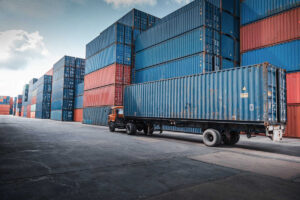What Is Intermodal Shipping? This is the movement of cargo by use of more than one mode of transport as the product makes its way from the shipper to the consignee. It is broadly categorized into two modes of shipment transport: international intermodal (by ship) and domestic intermodal (by rail).
The products usually stay in the same container throughout the whole process with some exceptions. Rail product cargo can be transloaded to a new container or truck, split-loaded into multiple containers or trucks, or reworked in the railyard due to improper cargo securement.
International Intermodal
For international intermodal shipments, the freight is packed into 20 ft or 40 ft containers then moved via truck and ocean carriers. The product being transported stays in the same container until arriving at its final destination.
Cargo Movement
A typical freight movement cycle starts with a truck picking up a shipping container from the shipper’s warehouse and hauling it to a port. Then at its destination port/railyard, a second truck hauls the container to its final destination, the consignee’s warehouse.
Here’s a step-by-step breakdown of the intermodal shipping involving movement by ship
- The products are first loaded into the container
- The container is then placed on the chassis of a truck
- The truck then hauls the container to the intermodal ramp (known as drayage)
- At the ramp, the container is taken off the truck chassis and placed onto an awaiting ship
- Once the freight arrives at its final destination port, it can be placed onto another truck chassis and hauled to its final destination, the consignee’s warehouse.
Domestic Intermodal
For the domestic intermodal shipments, the freight travels in 53 ft containers via rail. Since some products might arrive via international modal first, they must be transloaded from 20 or 40 ft containers into 53 ft rail cars.
This transfer can take place at either, a transload, cross-docking, or distribution center facility; or by a railyard transloading specialist. The cargo’s identity is then changed to domestic intermodal as it’s finally delivered to its inland destination.
Cargo Movement
If the freight then requires rail travel before reaching its final destination, it’s then transloaded into a 53 ft railcar.
Here’s a step-by-step breakdown of the intermodal shipping involving movement by train:
- The cargo is first transferred into a 53 ft railcar at a transload facility, cross-docking facility, or a rail distribution center near the port.
- Once the cargo is secured loaded in the 53 ft railcar, it’s then moved by train to the intermodal railyard closest to its final destination.
- At the yard, the container is then off-loaded onto a truck chassis, or further transloaded or split-loaded into different sized containers that trucks then haul to the consignee’s warehouse.
Best Shipping Practices
Be sure to follow these shipping practices to minimize your costs and maximize your efficiency.
Identify Savings Opportunities
Intermodal shipping is a solid selection when it comes to cargo movement of LTL (less-than-truckload) shipments more than once a week to the same destination. In addition to being cost-effective, it’s also a great way of reducing a company’s carbon footprint.
Use Proper Shipping Practices
You must ensure that you brace and block your shipments carefully, by strictly following the AARP Loading Guidelines that are specifically tailored to your specific cargo. This will ensure there is no freight movement while the train is in motion. Failure to do so can lead to steep fines, as well as requiring reworking, transloading, or split-loading of cargo prior to railyard release.
Work with an Experienced Service Provider
When you team up with a rail services expert like Container Solutions, they will be able to guide you through the process from beginning to the end, as well as be able to solve any issues that happen along the way.
Benefits of Intermodal Shipping
There are many practical benefits associated with intermodal shipping that include:
- Increased sustainability and security
- Movement efficiency even when crossing borders
- On-time reliability, capacity and reduced highway congestion
Sustainability
As opposed to moving cargo by hauling trucks alone, intermodal transportation offers extra environmental-friendliness and sustainability to your shipping movement. The superior fuel efficiency of rail movement and the ability to transport more weight are two of the key selling points in rail transportation.
Rail cargo movement allows for a steady flow of products with few traffic or weather issues, along with being a more economical and financially feasible alternative to gasoline or diesel fuel truck-hailing.
For instance, a single train moves an average of 280 truckloads, which greatly minimizes fuel consumption, loss of natural resources, and carbon emissions.
Increased Security Levels
Unless there is a track emergency, trains will stay in motion consistently and only stop in heavily secured rail yards.
Trucks, on the other hand, will be travelling on open highways, while making several stops along to their destination. When the trucks are left unattended, such as for coffee or washroom breaks, this increases the risk of robbery, carjacking, and loss of goods.
Reduced Highway Congestion
The intermodal transport system mediates this issue by taking the shipment off the road and onto a railway line. Shipped products can easily reach their destinations on time as there is no traffic to navigate through.
It’s near impossible to limit the obstacles that truck haulers have to deal with daily. Any highway-related delays, such as accidents or construction will cause time delays ripples in the supply chain. And, that’s on top of operator delays such as extended rest breaks, flat tires, and mechanical issues.
Reliable Capacity
Intermodal containers are easily double-stacked on high volume trains, while weather shipment weight and driving route terrain are of restricted limits dual-container truck haulers.
Intermodal lanes provide easy movement for multiple containers at one time- whereas traffic backups in designated truck lanes will steadily increase supply chain delays.
Optimizes the Efficiency of Truck and Rail
If you’re running short-distance hauling routes, then trucks make are more flexible compared to trains. For anyone who long hauls cargo though, shipment by rail makes the most sense.
Intermodal transport optimizes supply chain efficiency by running on a tight, but accurate schedule and allowing you to GPS pinpoint your cargo’s arrival time.
The heavier load capacities, as well as the ability to ship multiple containers on the same trip, make for timely and effective cargo movement.
Smooth Cross Border Shipping
Cross-border shipping can be a challenge and is prone to numerous types of delays for trucks at entry and exit points. Intermodal shipments, however, provide swift movement of goods across borders due to timely delivery and clearance processes.
FAQ
Below you’ll find the answers to frequently asked questions about intermodel shipping.



